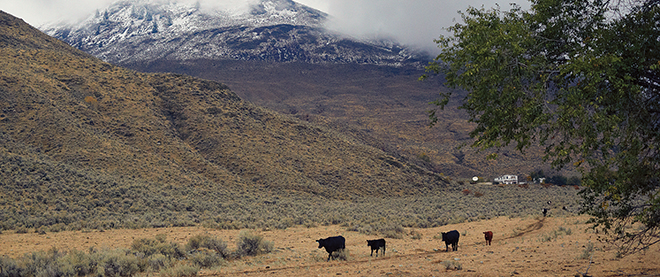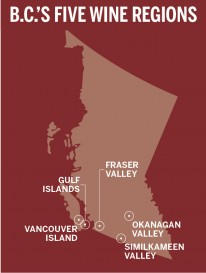The new frontier
Small wineries are capitalizing on unique microclimates in B.C., making some complex and interesting wines distinct from the Okanagan
Photograph by John Cullen
Share

Geography has always defined Canada, and weather is a national obsession. Both are critical to the production of Canadian wine from Nova Scotia to British Columbia. Maclean’s Wine in Canada: A Tour of Wine Country details the dedication and tenacity of grape growers and winemakers in a sumptuous, 145-page magazine that combines feature writing, stunning photography, tasting notes and insider’s tips from some of the nation’s top sommeliers. Look for it on newsstands now, or download the app. In the meantime, check out excerpts from B.C. sommeliers Kurtis Kolt and, below, Rhys Pender.
 As the sun shines on the Okanagan, so has attention been soaked up by the wine region that calls 80 per cent of the province’s vineyards and most of its wine production home. But microclimates also abound, and some of the smaller regions are starting to steal the limelight.
As the sun shines on the Okanagan, so has attention been soaked up by the wine region that calls 80 per cent of the province’s vineyards and most of its wine production home. But microclimates also abound, and some of the smaller regions are starting to steal the limelight.
The largest of the four other designated viticultural areas (DVAs) is the Similkameen Valley just west of Osoyoos, which accounts for seven per cent of B.C.’s vineyards. With a long history of grape growing, the region once supplied neighbouring Okanagan wineries with many of its finest grapes. Now a dozen Similkameen wineries are making complex and interesting wines distinct from those found just a 30-minute drive away.
The Similkameen climate is very similar to the south Okanagan: hot, dry and sunny. But the hills and mountains are a little steeper and more severe, and a piercing wind can howl through the rugged valley. You can actually see the terroir in the eroding rock of the mountainsides and ancient gravel riverbeds. Couple this with the complex deposit of soils from glacial action, and you can imagine the complexity of the earth that nourishes Similkameen vines.
Typically, the wines have a more mineral backbone, are less fruit-forward and often boast more complexity, elegance and subtlety than those from the Okanagan, while the tannins in the reds are typically gentler. Greatly varying conditions in an area that winds from Keremeos through Cawston to the U.S. border mean a large range of wines. The vineyards along the river near Keremeos are shaded early in the day and experience cooler temperatures compared to the sun-drenched terraces around Cawston. The best white varieties are riesling and chardonnay; the best reds are gamay, pinot noir, syrah, merlot and cabernet franc. White rhône blends are also showing potential.
The Similkameen is full of small producers who often farm their own land, resulting in an increasing number of single-vineyard wines that properly reflect the terroir. Visiting the winery shops, it is not uncommon to find the owners behind the tasting bar.
The other three DVAs amount to just eight per cent of B.C.’s acreage. The climate in these coastal regions is significantly different from the extreme hot and cold in the Interior. The strong maritime influence means mild and moderate temperatures, cool summers and warm winters. There is only enough summer heat and sun to successfully grow varieties that ripen early in the season. Heavy rainfall at harvest is a risk. The Fraser Valley DVA is close to the Vancouver market, so wineries often supplement their small local plantings with grapes trucked in from the Okanagan or Similkameen to meet the demand of wine-loving city-dwellers.
Vancouver Island DVA has a longer history of grape production, with nearly 30 wineries growing grapes and making small amounts of wine that sell mostly to the local population. The best area is the Cowichan Valley. Well shielded from the harshest Pacific storms, it can produce good-quality pinot noir and other early- to mid-season-ripening grape varieties such as gamay and pinot gris. The tiny B.C. Gulf Islands DVA experiences a similar climate.
In recent years, a number of new vineyards have been planted in other parts of the province. Vineyards near Spallmucheen-Shuswap, Kamloops, Lillooet, Lytton, Creston, Trail, Castlegar and Grand Forks have had some success and now make up three per cent of the acreage, many with the potential for quality wine. The expanding range of interesting B.C. terroir ensures we will have plenty of diverse wine to taste well into the future. The Wild West has a few more wine tales to tell.
B.C. tasting notes
Wine in Canada features more than 100 tasting notes from some of the country’s top sommeliers. Here is a sampling from British Columbia:
Okanagan Valley:
BLUE MOUNTAIN VINEYARDS
RED: 2011 Gamay Noir
Gamay is starting to get attention in B.C. and this one is special: intense floral, cherry, raspberry, dried scrubby herbs, truffle and cinnamon hearts. The palate is tart, juicy, fresh and long, begging for grilled quail. $21 —Rhys Pender
FOXTROT VINEYARDS
WHITE: 2011 Chardonnay
Sweet brioche and cream waft up the glass, leading into a fresh but full palate of white blossom, ripe pear and vanilla perfume with hazelnuts woven throughout. This Naramata Bench white is well suited to lobster or crab with butter and lemon. $45 —Treve Ring
Similkameen Valley:
HERDER WINERY & VINEYARDS
RED: 2009 Josephine
The evocatively labelled blend is merlot dominant, with cabernet sauvignon and cabernet franc playing supporting roles. Smooth and polished, with rich coffee, black cherry and cassis jam overlying a bed of fresh cedar chips. A touch rustic and stony, much like the Similkameen Valley. $50 —TR
CLOS DU SOLEIL
WHITE: 2010 Capella
Capella is 90 per cent sauvignon blanc with 10 per cent sémillon for weight, and combines black-currant leaf, mineral and pear with some fleshy tropical sémillon richness. The well-integrated oak provides a subtle backdrop and texture to the racy grapefruit and riper honeydew, mango and pineapple notes. Try it with spot-prawn ravioli and lemon cream sauce. $25 —RP
Vancouver Island:
AVERILL CREEK VINEYARD
RED: 2009 Reserve Pinot Noir
Andy Johnston’s 16-hectare Cowichan Valley estate has produced not only some of Vancouver Island’s best pinots, but their elegance and finesse have made them some of Canada’s best, as well. Spiced cherries and dark plums dominate, with some silky, herbaceous qualities that beg for fresh, grilled salmon. $60 —Kurtis Kolt
VENTURI SCHULZE
SPARKLING: 2009 Brut Naturel
The cool maritime influence on Vancouver Island can give a long, slow ripening well suited to bubbly. Fully dry, the brut naturel has zingy acidity, tart green apple, peach and fresh lemon backed by subtle yeasty and caramel notes. A natural pairing with all the fantastic oysters raised along the island’s coast. $19 (375 mL) —RP
Gulf Islands:
GARRY OAKS WINERY
WHITE: 2012 Pinot Gris
Among the artisan cheeses, family farms and dreadlocked inhabitants of dreamy Saltspring Island, you’ll find this tiny four-hectare estate winery that does us all proud. For those looking for a pinot gris with some richness, soak up this version full of nectarines, buckwheat honey and meyer lemon. $22 —KK
